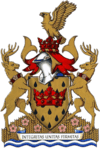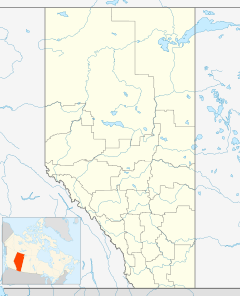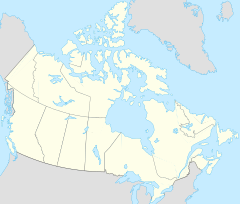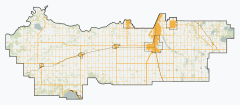Leduc, Alberta facts for kids
Quick facts for kids
Leduc
|
|||||
|---|---|---|---|---|---|
|
City
|
|||||
| City of Leduc | |||||
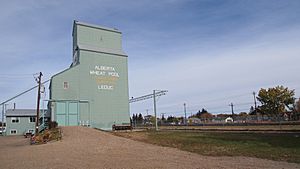
Leduc Grain Elevator
|
|||||
|
|||||
| Motto(s): | |||||
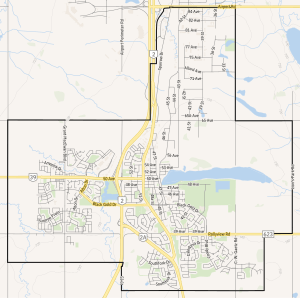
City boundaries
|
|||||
| Country | Canada | ||||
| Province | Alberta | ||||
| Region | Edmonton Metropolitan Region | ||||
| Municipal district | Leduc County | ||||
| Incorporated | |||||
| • Village | December 15, 1899 | ||||
| • Town | December 15, 1906 | ||||
| • City | September 1, 1983 | ||||
| Area
(2021)
|
|||||
| • Land | 42.25 km2 (16.31 sq mi) | ||||
| Elevation | 730 m (2,400 ft) | ||||
| Population
(2021)
|
|||||
| • Total | 34,094 | ||||
| • Density | 806.9/km2 (2,090/sq mi) | ||||
| • Municipal census (2019) | 33,032 | ||||
| • Estimate (2020) | 34,216 | ||||
| Time zone | UTC−07:00 (MST) | ||||
| • Summer (DST) | UTC−06:00 (MDT) | ||||
| Forward sortation area |
T9E
|
||||
| Area code(s) | 780, 587, 825, 368 | ||||
| Highways |
|
||||
| Railways | Canadian Pacific Kansas City | ||||
| Public transit | Leduc Transit | ||||
Leduc (pronounced "lə-DEWK") is a city in the province of Alberta, Canada. It is about 33 kilometers (20 miles) south of Edmonton, Alberta's capital city. Leduc is part of the larger Edmonton Metropolitan Region.
Contents
History of Leduc
Leduc was started in 1891 by a settler named Robert Telford. He bought land near a lake, which is now called Telford Lake. This land became the center of the new settlement. Telford set up a stopping place for stagecoaches traveling between Calgary and Edmonton. This place was known as Telford's Place.
Robert Telford was an important person in Leduc's early days. He was the first postmaster, the first general store owner, and the first justice of the peace. He was also elected as Leduc's first Member of the Alberta Legislature (MLA) in 1905.
The arrival of the Calgary and Edmonton Railway in July 1891 helped the area grow. This railway later became part of the Canadian Pacific Railway.
How Leduc Got Its Name
There are two true stories about how Leduc got its name. In April 1886, a settler named McKinley needed a name for a new telegraph office. He decided to name it after the first person who walked through the door. That person was Father Hippolyte Leduc, a priest who had worked in the area since 1867.
Five years later, in 1891, the government official Edgar Dewdney was given a list of names for the new railway station. Father Leduc's name was on this list. Since the telegraph station was already called Leduc, Dewdney decided to use the same name for the new railway station and the growing community.
Leduc's Growth
Leduc officially became a village in 1899. It then grew into a town in 1906. By 1983, Leduc had a population of 12,000 people and became a city.
A very important event for Alberta happened near Leduc. On February 13, 1947, a huge amount of oil was discovered at the Leduc No. 1 oil well. This discovery greatly boosted Alberta's economy.
Geography and Nature
Leduc has many parks and sports areas. It also has over 35 kilometers (22 miles) of paths for walking and biking. Telford Lake is on the east side of the city, and Saunders Lake is just east of that.
Lakes and Ponds
Leduc is home to several bodies of water:
- Alexandra Park Ponds
- Coady Lake
- Leduc Reservoir
- Telford Lake
- West Point Lake
Leduc's Climate
Leduc has a climate with warm, rainy summers and cool nights. Winters are long, very cold, and usually dry, with some snowfall. Most of the rain falls in July, which is also the sunniest month of the year.
| Climate data for Leduc-Edmonton (Edmonton International Airport) WMO ID: 71123; coordinates 53°19′N 113°35′W / 53.317°N 113.583°W; elevation: 723.3 m (2,373 ft); 1981–2010 normals, extremes 1959–2010 |
|||||||||||||
|---|---|---|---|---|---|---|---|---|---|---|---|---|---|
| Month | Jan | Feb | Mar | Apr | May | Jun | Jul | Aug | Sep | Oct | Nov | Dec | Year |
| Record high humidex | 9.2 | 12.8 | 23.5 | 30.0 | 33.6 | 37.3 | 43.0 | 38.7 | 33.9 | 28.4 | 18.5 | 14.6 | 43.0 |
| Record high °C (°F) | 9.9 (49.8) |
13.3 (55.9) |
24.2 (75.6) |
30.5 (86.9) |
32.8 (91.0) |
34.4 (93.9) |
35.0 (95.0) |
35.6 (96.1) |
34.9 (94.8) |
29.1 (84.4) |
18.8 (65.8) |
15.9 (60.6) |
35.6 (96.1) |
| Mean daily maximum °C (°F) | −6.3 (20.7) |
−3.8 (25.2) |
1.2 (34.2) |
10.8 (51.4) |
17.4 (63.3) |
20.6 (69.1) |
22.8 (73.0) |
22.2 (72.0) |
17.4 (63.3) |
10.4 (50.7) |
−0.1 (31.8) |
−5.5 (22.1) |
8.9 (48.1) |
| Daily mean °C (°F) | −12.1 (10.2) |
−9.9 (14.2) |
−4.4 (24.1) |
4.2 (39.6) |
10.2 (50.4) |
14.1 (57.4) |
16.2 (61.2) |
15.2 (59.4) |
10.2 (50.4) |
3.8 (38.8) |
−5.4 (22.3) |
−11.0 (12.2) |
2.6 (36.7) |
| Mean daily minimum °C (°F) | −17.7 (0.1) |
−15.9 (3.4) |
−10.0 (14.0) |
−2.5 (27.5) |
3.0 (37.4) |
7.6 (45.7) |
9.5 (49.1) |
8.1 (46.6) |
3.0 (37.4) |
−2.9 (26.8) |
−10.6 (12.9) |
−16.5 (2.3) |
−3.7 (25.3) |
| Record low °C (°F) | −48.3 (−54.9) |
−43.9 (−47.0) |
−42.7 (−44.9) |
−28.3 (−18.9) |
−11.6 (11.1) |
−6.1 (21.0) |
−1.0 (30.2) |
−3.8 (25.2) |
−9.6 (14.7) |
−26.5 (−15.7) |
−36.4 (−33.5) |
−46.1 (−51.0) |
−48.3 (−54.9) |
| Record low wind chill | −61 | −54 | −51 | −34 | −16 | −7 | −4 | −6 | −14 | −35 | −51 | −58 | −61 |
| Average precipitation mm (inches) | 20.8 (0.82) |
11.9 (0.47) |
16.5 (0.65) |
28.7 (1.13) |
49.4 (1.94) |
72.7 (2.86) |
95.6 (3.76) |
54.9 (2.16) |
41.3 (1.63) |
22.6 (0.89) |
17.3 (0.68) |
14.5 (0.57) |
446.2 (17.56) |
| Average rainfall mm (inches) | 1.4 (0.06) |
0.5 (0.02) |
0.9 (0.04) |
14.9 (0.59) |
42.9 (1.69) |
72.7 (2.86) |
95.6 (3.76) |
54.9 (2.16) |
40.3 (1.59) |
12.6 (0.50) |
1.6 (0.06) |
0.8 (0.03) |
339.1 (13.36) |
| Average snowfall cm (inches) | 21.7 (8.5) |
13.4 (5.3) |
17.5 (6.9) |
14.4 (5.7) |
6.5 (2.6) |
0.0 (0.0) |
0.0 (0.0) |
0.1 (0.0) |
1.1 (0.4) |
10.4 (4.1) |
17.3 (6.8) |
15.9 (6.3) |
118.3 (46.6) |
| Average precipitation days (≥ 0.2 mm) | 10.2 | 8.1 | 9.2 | 8.2 | 11.3 | 13.8 | 14.7 | 11.7 | 9.8 | 8.2 | 8.6 | 9.3 | 123.1 |
| Average rainy days (≥ 0.2 mm) | 1.1 | 0.6 | 5.3 | 1.3 | 10.7 | 13.8 | 14.7 | 11.7 | 9.7 | 5.7 | 1.6 | 0.67 | 76.87 |
| Average snowy days (≥ 0.2 cm) | 9.9 | 8.3 | 8.4 | 4.1 | 1.6 | 0.0 | 0.0 | 0.03 | 0.5 | 3.3 | 7.8 | 9.3 | 53.23 |
| Average relative humidity (%) | 68.0 | 65.8 | 62.4 | 45.3 | 41.2 | 49.4 | 54.3 | 52.4 | 49.0 | 51.7 | 67.4 | 68.8 | 56.3 |
| Mean monthly sunshine hours | 101.1 | 127.0 | 174.7 | 233.3 | 271.0 | 275.9 | 302.2 | 279.4 | 196.1 | 160.4 | 97.2 | 92.0 | 2,310.3 |
| Percent possible sunshine | 40.1 | 45.9 | 47.6 | 55.7 | 55.1 | 54.4 | 59.3 | 61.0 | 51.3 | 48.7 | 37.3 | 39.0 | 49.6 |
| Source: Environment and Climate Change Canada (July record high humidex) Note: located 14 nautical miles (26 km; 16 mi) south southwest of Downtown Edmonton |
|||||||||||||
Population of Leduc
Leduc has been growing steadily over the years.
|
|||||||||||||||||||||||||||||||||||||||||||||||||||||||||||||||||||||||||||||||||
In the 2021 Census, 34,094 people lived in Leduc. This was a good increase from 2016, when the population was 29,993. The city covers an area of about 42.25 square kilometers (16.31 square miles).
Different Backgrounds in Leduc
Leduc is a diverse city with people from many different backgrounds. The table below shows how the different groups have changed over time.
| Panethnic group | 2021 | 2016 | 2011 | 2006 | 2001 | |||||||||
|---|---|---|---|---|---|---|---|---|---|---|---|---|---|---|
| Pop. | % | Pop. | % | Pop. | % | Pop. | % | Pop. | % | |||||
| European | 27,040 | 80.33% | 25,185 | 84.94% | 21,490 | 89.21% | 15,905 | 94.79% | 14,030 | 94.99% | ||||
| Indigenous | 2,345 | 6.97% | 1,615 | 5.45% | 1,140 | 4.73% | 500 | 2.98% | 460 | 3.11% | ||||
| Southeast Asian | 2,065 | 6.13% | 1,275 | 4.3% | 600 | 2.49% | 140 | 0.83% | 40 | 0.27% | ||||
| South Asian | 680 | 2.02% | 450 | 1.52% | 265 | 1.1% | 65 | 0.39% | 15 | 0.1% | ||||
| African | 635 | 1.89% | 570 | 1.92% | 280 | 1.16% | 70 | 0.42% | 155 | 1.05% | ||||
| Latin American | 340 | 1.01% | 70 | 0.24% | 10 | 0.04% | 0 | 0% | 0 | 0% | ||||
| East Asian | 250 | 0.74% | 240 | 0.81% | 140 | 0.58% | 60 | 0.36% | 30 | 0.2% | ||||
| Middle Eastern | 125 | 0.37% | 210 | 0.71% | 85 | 0.35% | 35 | 0.21% | 40 | 0.27% | ||||
| Other/multiracial | 170 | 0.51% | 25 | 0.08% | 50 | 0.21% | 0 | 0% | 10 | 0.07% | ||||
| Total responses | 33,660 | 98.73% | 29,650 | 98.86% | 24,090 | 99.12% | 16,780 | 98.9% | 14,770 | 98.26% | ||||
| Total population | 34,094 | 100% | 29,993 | 100% | 24,304 | 100% | 16,967 | 100% | 15,032 | 100% | ||||
| Note: Totals greater than 100% due to multiple origin responses | ||||||||||||||
Leduc's Economy
Leduc is a key part of "Alberta's International Region." This area is close to the Edmonton International Airport. Leduc is also located on the CANAMEX Corridor, which is an important trade route. Two Canadian Pacific Kansas City railway lines also run through the city. These transportation links help support industries in other parts of Alberta, like the oil and gas areas.
The oil and gas industry has always been very important to Leduc's economy. The Leduc Business Park, in the northern part of the city, has over 1,400 businesses. The Nisku Industrial Park, just north of Leduc, also has many businesses.
Arts and Culture in Leduc
Leduc has a great place for performances called the Maclab Centre for the Performing Arts. It has a theater with 460 seats.
In 2009, the Leduc Recreation Centre (LRC) opened. This huge building is about 309,000 square feet. It includes:
- Three ice hockey arenas
- A swimming center
- An 8-sheet curling rink
- Two large multi-use sports fields
- A 9,000 square foot fitness center
- A 4-lane running track
- Restaurants and child care facilities
- Several meeting rooms
In 2022, Curling Stadium Leduc opened inside the Leduc Curling Club. It allows live broadcasts of all games played there.
Next to the LRC is William F. Lede Park, which is 200 acres. This park offers:
- 7 baseball diamonds
- Beach volleyball courts
- A soccer field
- Two rugby fields with a clubhouse
- Two smaller soccer fields for younger players (U-12)
- Community gardens
- A 40-acre off-leash dog park
- Access to 8 kilometers (5 miles) of trails around Telford Lake
The Leduc Boat Club is also near the rugby house. In 2004, the club made Telford Lake ready for rowing sports. It even hosted the 2005 World Masters Games.
Media in Leduc
Leduc has its own local newspaper, the Leduc Representative (also known as the Leduc Rep). There is also a regional newspaper called the Leduc-Wetaskiwin Pipestone Flyer.
Leduc's first FM radio station, CJLD-FM, started in 2013. It is known as "93.1 The One." There is also an internet-based community radio station called "Leduc Radio," which has been serving the city since 2008.
Because Leduc is close to Edmonton, all the major news, radio, and TV channels from Edmonton also serve Leduc and the areas around it.
Emergency Services
The City of Leduc has its own fire and emergency management departments. The Fire Services Department has full-time and part-time members. They provide fire, ambulance, and patient transportation services to the city and parts of Leduc County.
The Royal Canadian Mounted Police (RCMP) are in charge of police services in Leduc. They are supported by the city's Enforcement Services Department, which has Peace Officers.
See also
 In Spanish: Leduc (Alberta) para niños
In Spanish: Leduc (Alberta) para niños



